Option C - Ecology
1/52
There's no tags or description
Looks like no tags are added yet.
Name | Mastery | Learn | Test | Matching | Spaced |
|---|
No study sessions yet.
53 Terms
Limiting Factor
Any biotic or abiotic factor that restricts the existence, numbers, reproduction, or distribution of organisms.
- defines optimal survival conditions according to its effect on species in deficit/excess
Biotic: intraspecific or interspecific
Abiotic: light, pH, wind, rain
Gersmehl Diagrams in Different Biomes
Tropical Rainforest
- most nutrients stored in biomass (litter decomposes quickly + roots quickly draw nutrients from soil)
- fast rate of transfer b/w stores (hot/wet conditions -> rainfall, runoff, weathering, etc.)
Taiga
- most nutrients = litter (low temp -> slow decompose -> slow nutrient transfer to soil/biomass)
- little nutrients from rainfall/weathering
- little nutrient loss from leaching + some loss from runoff (snow)
Desert
- most nutrients = soil (few plants for biomass or litter)
- little nutrients from rainfall + little loss from rainfall
- weathering + leaching negligible
Law of Tolerance
Populations have optimal survival conditions w/in critical min. + max thresholds
As pop. is exposed to extremes of lim. factor, survival rates drop (bell curve)
- Optimal zone: central part of curve w/ conditions for max reproductive success/survival
- zones of stress: organisms can survive but w/ less repro success
- zones of intolerance: outermost, organisms cannot survive
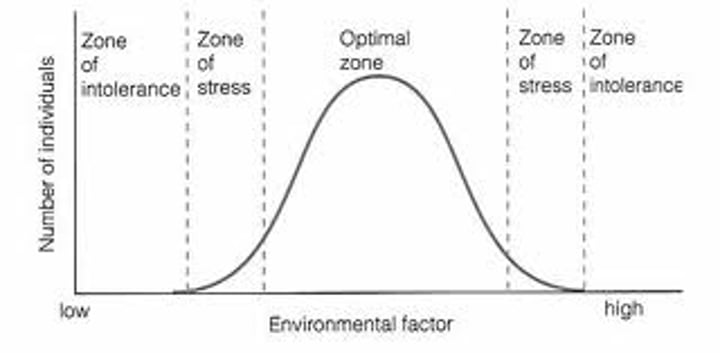
Plant example of zone of tolerance
Plant growth varies depending on salinity in soil
- glycophytes: salt intolerant, damaged by high salinity
- halophytes (very few plant): salt tolerant, stressed in freshwater
Agricultural cultivation -> water table rises + salt concentrated at roots -> hard for glycophytes to extract water from soil (salt = toxic for them)
Animal Example of zone of tolerance
Corals connect through reefs that are temp. sensitive
- coral polyps get nutrients from zooxanthellae (algae) cannot survive in low (<18 C) or high ocean temp. (> 35 C)
- inc. ocean temp -> algae leaves coral -> coral bleaching
Coral survives best at 20-30 C (temperate waters in tropical/subtropical regions)
Quadrats
rectangular, known dimensions, est. pop. densities
- placed at regular intervals along transect line
- showing changing distribution patterns of species (in response to another species or abiotic variable)
- used to identify optimal conditions
- count how many organisms of a species are w/in each quadrat (has to be used on non-mobile organism)
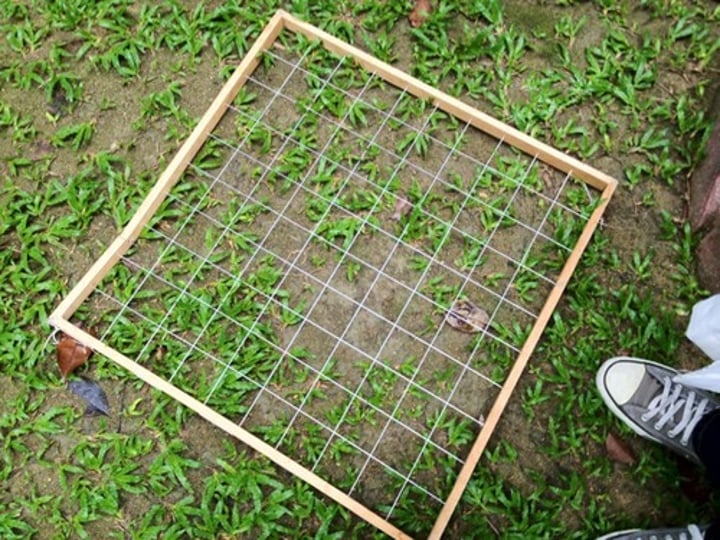
Transects
Straight line along abiotic gradient, pop. data is recorded to assess species distribution in correlation to abiotic factor across a measurable distance
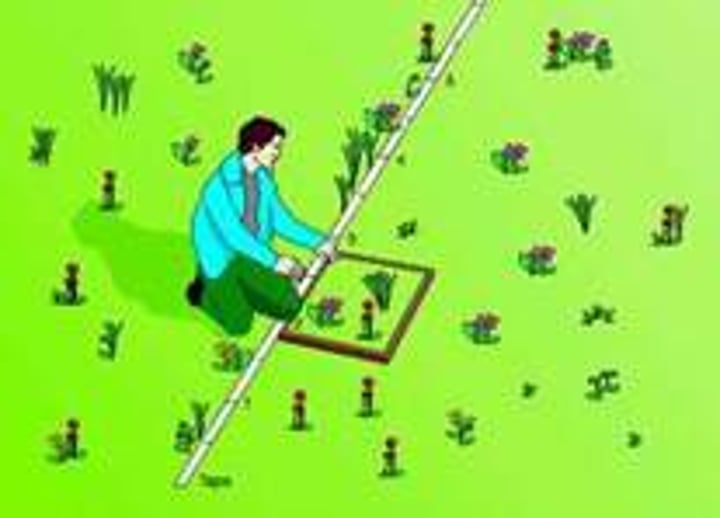
Kite Graph
Represents the changes of distribution along the transect
- width of kite represents abundance of organism
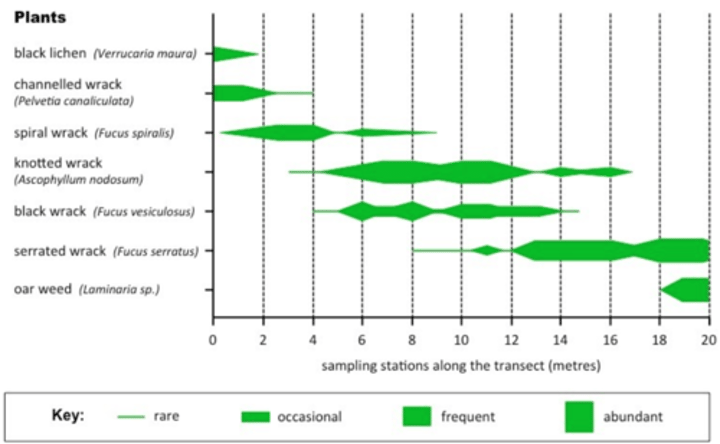
Ecological niche
functional role of organism w/in its environ.
- Consists of all physical and bio conditions that determine their survival/reproduction
Comprised of various components:
- Habitat
- resources from its environment
- activity patterns (when is it active/inactive)
- interactions w/ other species in community (predator prey, competition)
What occurs if 2 species share an identical niche?
Interspecific competition for resources
- results in fitness of one being lowered by presence of other (negative correlation)
1. Competitive exclusion: one species uses resources better -> other species finds new niche, dies out, or moves away
2. Resource partitioning: both species alter their niches to divide resources b/w them (niche separation)
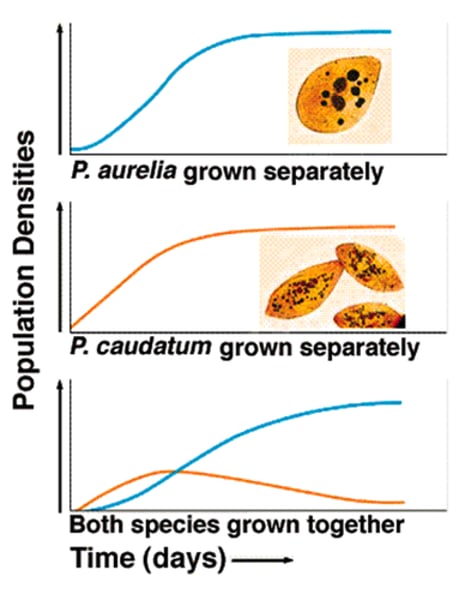
Fundamental Niche
All possible conditions organism can live
- theoretical habitat: may not be fully occupied due to presence of competing species
o Essentially where it could survive if it was isolated, no competition
Realized Niche
- conditions used by organisms IRL (where it actually lives) In its actual habitat in the presence of competing species
Herbivory
interaction in which one animal (the herbivore) feeds on producers (such as plants)
o Can be harmful or beneficial to plant species:
- Certain beetles feed on leaves/foliage of crop plants (folivores) -> crop failure
- Fruit-eating (frugivores) spread seeds of fruit in feces -> seed dispersal
Predation
One organism (predator) hunts that feeds on another (prey)
o Predator relies on prey -> population levels are intertwined
- Dec. prey (overfeed) -> predators decrease (b/c of inc. competition)
- Inc. prey -> inc. predator (over-abundance)
Symbiosis
Relationships that are beneficial to either one or both species
- can be obligate (required for survival)
or facultative (advantageous w/o being necessary)
Mutualism
Both benefit
- Sea anemone prot. clownfish -> clownfish provides feces as food
Commensalism
One species benefit, other is unaffected
- Remora attach to shark and eat the scraps from the shark
Parasitism
One species benefits to detriment of the other
- ticks on dogs
- Tongue-eating louse on fish
Application: symbiotic relationship b/w Zooxanthellae (algae) and reef-building coral
Coral provides algae w/ protective environment in endodermis + source of inorganic compounds
- Give them CaCO3 to build skeleton that encases polyps and algae
- polyps recycle waste products of algae and supply w/ CO2
o Algae provides coral polyps w/ nutrition (oxygen, glucose, etc. from photosys)
o Algae helps coral remove waste products
o Large-scale loss of algae -> coral bleaching -> coral starves and dies unless algae is restored
- Coral bleaching is caused by: changes in light availability (sediment blocking light), temp. increases, ocean acidification (lower pH stresses algae).
Keystone species
One that has a disproportionately large impact on environment relative to its abundance. Prevents entire structure from falling apart. Influence community as:
o Predators - exert pressure on lower tropic levels to prevent them from overfeeding.
- Sea stars pray on urchins + mussels to prevent mussel overpopulation + coral reef destruction by urchins
o Mutualism - support other species w/in communities (ex: pollinators)
- Honey bees pollinate wide variety of plant species
o Engineers - change the environment to promote survival of other species.
- Beavers build dams that transform environment
They are NOT the dominant/most numerous species nor do they have to be apex predators
Food web
network of complex interactions formed by the feeding relationships among the various organisms in an ecosystem (more representative than food chain)
- allows organisms to have more than 1 food source/predator
Organisms can occupy more than 1 trophic level
- when constructing foods web, position organism at their highest trophic level (diff trophic levels are shown through the arrows)
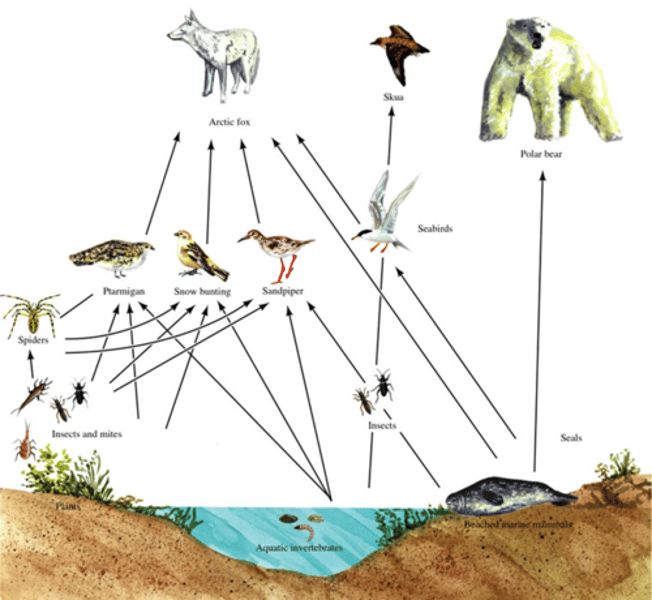
Primary Production
production of chemical energy in organic compounds by producers
- main source is sunlight but a fraction is driven by chemosynthesis by lithotrophs
1. Gross Primary Production: amnt of chemcial energy as biomass producer creates
2. Net Primary Production: amt of energy that is not consumed by respiration (GPP - respiration = NPP)
Secondary Production
generation of biomass by heterotrophs
- driven by transfer of organic compounds b/w trophic levels
- can also be categorized into gross (total) and net (usable) biomass
Feed Conversion Ratio
Measure of efficiency of animal in converting food into desired output
- Mass of feed / mass of desired output
- Lower ratio = more efficient method of food production
Lower ratio is done by minimizing potential loss of energy for animals (lower costs, but ethical issues)
- Restrict animal movement -> reduce cell. Resp.
- Optimize feeding practices -> food is digested more effectively
- Slaughtering at young age (older animals grow slower + higher FCR)
Ex: chickens have low FCR while beef has almost 10x the FCR
Closed ecosystem vs. Open Ecosystem
- Closed: exchanges energy but not matter w/ surroundings (self-contained, mesocosm)
- Open: exchanges energy and matter w/ surroundings (natural ecosystem)
Biome
Geo area that has particular climate and sustains specific community
o Main factors affecting distribution of biomes: temperature + rainfall (vary according to altitude, proximity to ocean + longitude/latitude)
Types of Biomes: tropical rainforest, taiga, desert, tundra
o Tropical rainforests: hot/humid near equator w/ dense vegetation + high biodiversity
o Taiga: coniferous forests near poles -> cold, little rain, moisture trapped in ice/snow
o Deserts: dry/arid w/ extreme temps (hot and cold)
o Tundra: Coldest temperatures, NO TREES (WAHHHH)
Climographs
diagram that shows combination of monthly avg. temperature and rainfall at specific location; used to identify seasonal patterns/changes
- Deserts: high temps but low precipitation
- Rainforests: high temps + high precipitation
- Taigas: low temps + low precipitation
- Robert Whittaker developed climographs to classify 9 distinct biomes.
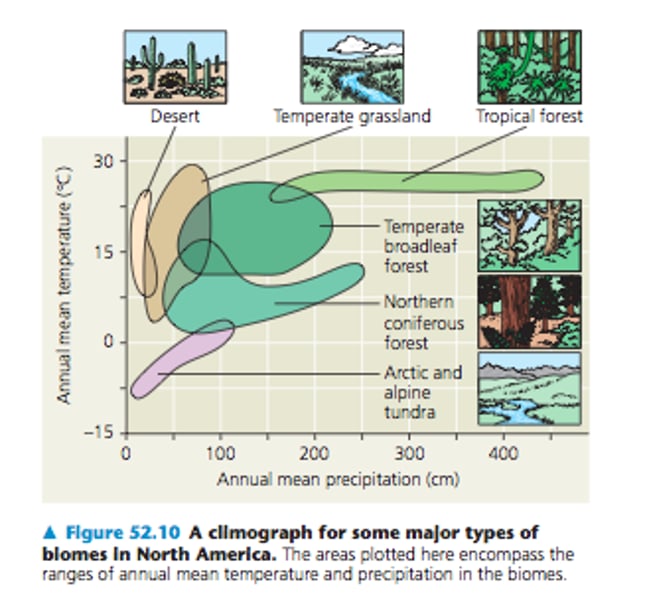
Pyramids of Energy
differ b/w ecosystems b/c of climate's effect on primary production
- Warm temp -> speed up enzyme reactions for photosynthesis
- High precipitation -> inc. photosynthesis
o Tropical rainforests have high NPP, deserts have low NPP
§ Higher productivity -> more energy to consumers -> support more trophic levels
§ Tropical rainforest has bigger base + more levels
- Types of species w/in biome effect how efficiently energy is transferred b/w lvls
o Homotherms use more energy to maintain stable body temperature than poikilotherms (less energy efficiency)
Gersmehl diagram
show differences in nutrient flow and storage b/w diff. types of ecosystems
- Nutrients are stored in 3 nutrient sinks and be transferred b/w them/cycled (reference photo):
o Biomass
o Litter: organic matter in/on soil (humus, leaf litter)
o Soil: top layer of earth w/ disintegrated rocks
- The arrows on the diagram show the loss/gain of nutrients
- Gersmehl diagrams are affected by climatic factors
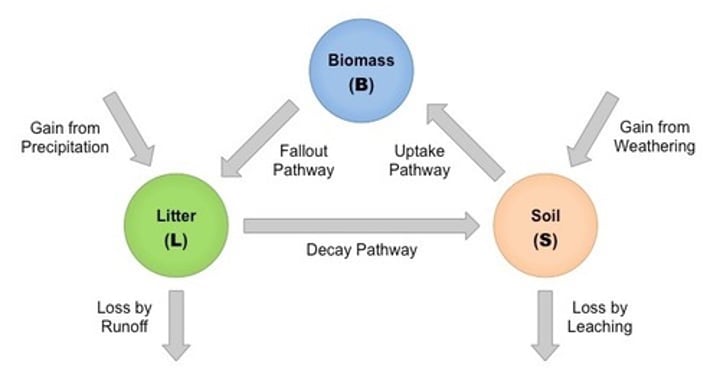
Ecological sucession
process of increasingly complex communities over time
- climax community - succession ended
Primary succession
Community on entirely new land
- Pioneer species 1st colonize region (lichen or moss)
o When they die -> decompose -> soil -> plant growth
- Plants colonize area -> litter produced from their growth/decomposition -> changes:
o Soil depth inc. (plants add humus (organic material formed in soil when plant/animal matter decay) to soil) and soil pH altered
o Soil mineral content inc. + rocks broken down by roots
o Soil aerated and water retention inc. (drainage reduced)
Allow for growth of larger plants which reduce erosion through binding of roots
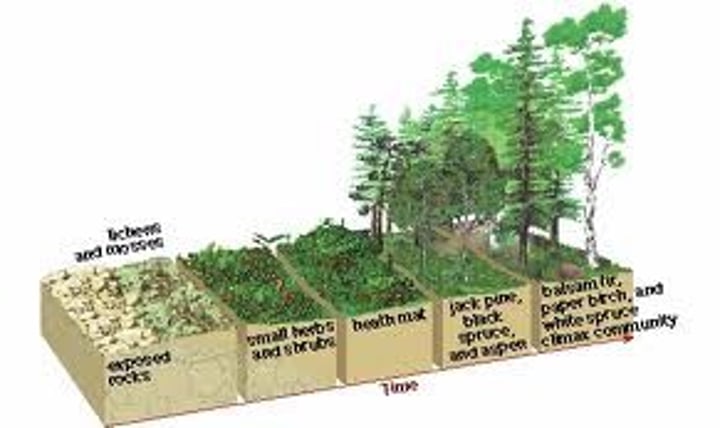
How can primary succession sequence be identified?
According to distribution of plants at site of eco. nascency
- new community emerges from uninhabitable land ((bare rock; usually at glaciers, dunes, river deltas)
- regions closer to site = earlier stages of succession
EX: Glacier retreat -> bare rock -> regions further from retreat are older/further stages of succession
- expected to have larger trees/closer to climax community
Secondary Succession
Often caused by natural disturbance; one ecosystem is replaced by another
- occurs on existing soil w/ no more biota b/c of disturbance
- soil already developed -> dominance is achieved by fastest growing plants
Progression of succession:
- environ. disturbance
- grasses/herbaceous plants grow back (no pioneer species needed)
- fast growing trees develop + shade tolerant trees under them
- climax community reestablished
Application: How do humans interfere w/ nutrient cycling through deforestation?
Less trees
-> less evapotranspiration - less moisture -> less rainfall
-> less leaves -> less litter -> less humus (less nutrients in soil)
Rapid loss of nutrients from leaching
Soil becomes acidic -> release Iron + Aluminum -> nutrient poor soil
- less vegetation + less biodiversity
Soil layer - thin + easily eroded
Removal of canopy -> loss of nutrients from runoff + more light exposure -> change distribution of plants
Invasive species
nonnative, few natural predators, growing out of control, negative effect on ecosystem b/c kill native species
-> ex: mountain goats, lionfish, murder hornets, Burmese python
- nonnative does not necessarily mean invasive
Endemic Species
A species that is found in its originating location and is generally restricted to that geographic area.
Competitive exclusion principle
Ecological rule that states that no two species can occupy the same exact niche in the same habitat at the same time
- 1 of the species will do better and take up the resources
- other will move out, change their niche, or die out
Cane Toads in Australia
Invasive species brought in to get rid of invasive sugarcane beetles
- grew exponentially and are HUGE w/ no natural predators b/c they are poisonous
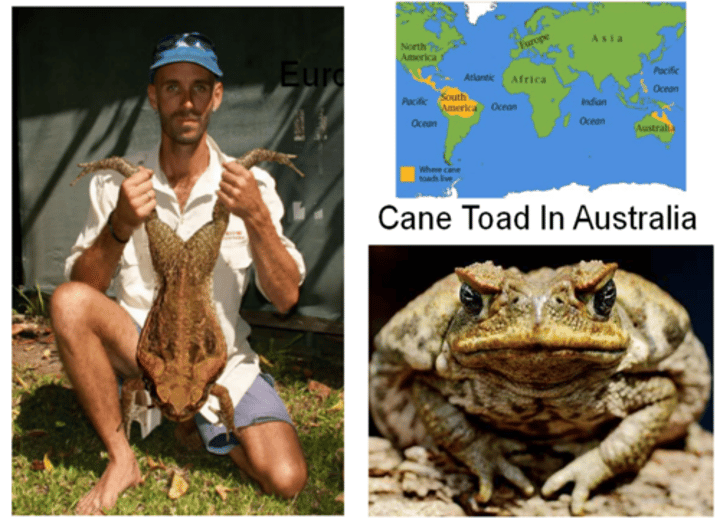
3 methods for controlling invasive species
1. biological control: use another organism to control them
2. chemicals such as pesticides or something that prevents them from reproducing
3. physical: humans remove them by uprooting them, cutting them down, trapping them or even physical barriers / removal of habitat
Biomagnification
accumulation of pollutants at successive levels of the food chain
Ex: DDT = pesticide to control mosquitos to prevent malaria BUT:
- lizards eat a bunch of mosquitos w/ DDT -> cats eat lizards-> and so on
As you move up chain, organisms live longer and thus eat more -> lingers longer in body
- stays in liver b/c they are fat soluble and not water soluble so cannot urinate out
Mercury: pregnant women cannot eat sushi (esp. not Tuna b/c it is at top of chain w/ a lot of mercury)
Microplastic vs. Macroplastic
Plastic = synthetic polymer, not biodegradable
- micro = smaller debris (like in your food)
- macro = large, you can see; can be broken down into micro using UV rays + ocean currents
Effects of Plastic Pollution
Leaches chemicals into water + absorb persistent organic pollutants
- microplastics absorb more (more surface area)
Both macro and micro are eaten by marine animals which think it is food
-> bioaccumulation + biomagnification of pollutants w/in animals
-> damage stomach -> stop eating b/c no longer feel hungry (take up space in stomach)
Albatross eat a bunch of plastic thinking it is jelly fish -> block esophagus or stay in stomach -> starve to death
Turtles get entangled in plastic rings or eat plastic
Indicator species
sensitive to environmental conditions and indicate health of community + presence of pollutant
- specific to environment
- in abundance -> not a lot of pollutant
- half of species -> some pollutants but not yet super deadly
- ex: lichen/moss are sensitive to pollutants dissolved in water
- ex: tubiflex worm is one of only species which can live in aquatic environ w/ high pollution
-> only tubiflex -> pollution is VERY BAD
Biotic Index Formula
Biotic index = Σ (ni × ai) / N
N = total # of organisms
ni = # of individuals of a species
ai = tolerance rating of species
Provides assessment of health of community
- high biotic index = presence of pollution-sensitive organism, unpolluted
- low biotic = polluted b/c many pollution-tolerant organisms
Can use indexes to compare 2 diff communities or same community over time
Biodiversity
how much variability of organisms in environ.
- species richness: how many diff. species
- species evenness: how evenly distributed are the species (low evenness = 1 species takes up 90% of community)
Simpson's Reciprocal Index of Diversity
DI = N(N-1) / Σ n(n - 1)
N = Total individuals collected
n = Number of individuals in a species
Higher index = more stable site w/ many niches + low competition
DI can change in response to eco disturbance
What factors affect biodiversity?
Larger habitat -> more biodiverse (support more niches -> less interspecific competition)
Ecology at edges of ecosys. is diff from center -> edges tend to be more biodiverse but edges can also limit survival b/c more competition
These factors are used to inc. biodiversity on reserves:
- better to have large size
- reserves w/ less "edge" are better than those w/ more
- clustered reserves better than isolated/fragmented
- habitat corridors are good
Edge effect
species distribution affected by divergent conditions
- edges have more diversity b/c diff habitats are close by w/ diff abiotic factors
- edges also have more competition which can restrict survival
- habitat corridors: b/w parts of fragmented habitat
Island Size
Biodiversity is proportionate to island size
- larger = more range of habitats + more niches
- more species pop. can be accommodated for
- more productivity at each trophic -> longer and more stable food chains
In situ conservation
preservation of species in nat. habitat
Requires: legislation for funding/edu, ecological monitoring of population, interventions to prevent degradation/competition from invasive species
Advantages:
- species lives in environ. they're adapted to + occupy nat. position in food chain
- maintain normal behaviors
- reserves share info, sci. study, awareness
- return animals from breeding programs for reintegration
- retain habitat + ensure habitat remains available for other endangered species
Ex situ conservation
preservation of species outside nat. habitat; usually for critically endangered species
Advantages:
- greater control of conditions + monitoring
- more chances of successful breeding through artificial methods
Disadvantages:
- does not prevent habitat destruction
- in captivity -> less likely to reintegrate
- more inbreeding
Ex: zoos, labs, botanical gardens (zoos for plants), seed banks
What does sara have a lot of?
sara is the best, she has a lot of biomass (no she doesn't this is going in my quizlet!! Let it be known! She has NOOOO BIOMASSSS)
